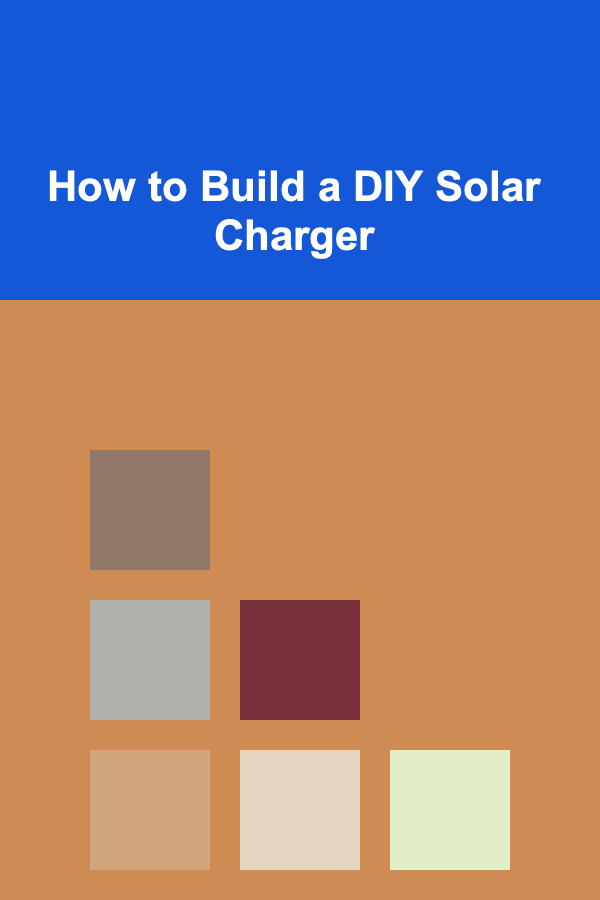
How to Build a DIY Solar Charger
ebook include PDF & Audio bundle (Micro Guide)
$12.99$8.99
Limited Time Offer! Order within the next:

In the modern world, where electronic devices play a crucial role in our everyday lives, finding sustainable and cost-effective ways to power these devices has become increasingly important. One such solution is solar charging, which leverages the power of the sun to provide renewable energy. Building your own DIY solar charger can be an incredibly rewarding project that not only helps you learn about solar power but also provides you with a functional, eco-friendly charging option.
This comprehensive guide will walk you through the step-by-step process of building your very own solar charger. From understanding the basic components and tools needed, to assembling the charger and testing its functionality, this guide aims to provide you with everything you need to get started.
Understanding Solar Power
Before diving into the process of building a solar charger, it is essential to understand how solar power works. At its core, solar power is energy harnessed from the sun, typically through the use of photovoltaic (PV) cells. These cells convert sunlight into electrical energy. The electricity generated can be used to power various devices, stored in batteries for later use, or even fed into the electrical grid.
A solar charger works on the same principle. It consists of solar panels (usually made up of PV cells), a charge controller, a battery, and sometimes an inverter. The solar panels convert sunlight into direct current (DC) electricity, which is then used to charge a battery or directly power a device.
Materials Needed
Building a solar charger requires a few basic materials and tools. These include:
Materials:
- Solar Panel(s): The most crucial component of your solar charger. The size and number of solar panels you need will depend on how much power you want your charger to generate. For a basic DIY charger, a panel with an output of around 6V to 12V is a good start.
- Charge Controller: This device regulates the voltage and current coming from the solar panel to ensure the battery doesn't get overcharged or damaged.
- Battery: A rechargeable battery is needed to store the energy generated by the solar panel. Common options include lead-acid, lithium-ion, or nickel-metal hydride (NiMH) batteries.
- DC-DC Converter (Optional): This can step up or step down the voltage, depending on the requirements of the device you plan to charge. For example, a 5V output for charging a smartphone.
- Blocking Diode: Prevents the battery from discharging back into the solar panel when there is no sunlight.
- Cables and Connectors: For connecting the components together.
- Junction Box (Optional): For organizing and protecting the electrical components.
- Soldering Iron: To make secure electrical connections between components.
- Multimeter: To test voltage and ensure the system works correctly.
Tools:
- Screwdriver: For mounting components.
- Wire Strippers: To strip insulation from wires for proper connections.
- Soldering Iron: To solder wires and components together.
- Drill (Optional): For mounting the solar panels if necessary.
Step-by-Step Guide to Building a DIY Solar Charger
Step 1: Design the System
Before starting to assemble the components, it's essential to design your system based on your needs. Consider the following:
- Power requirements: What devices do you want to charge, and how much power do they consume? For example, smartphones typically need 5V, while laptops may require 12V or 19V.
- Battery capacity: Determine how much storage capacity you need for the energy your solar panels generate. Larger batteries can store more power but take up more space and might require more solar panels to charge efficiently.
Once you have these requirements, you can determine the number and size of the solar panels you need, as well as the type of battery and charge controller.
Step 2: Prepare the Solar Panels
Start by preparing your solar panels. If you're using individual cells, you will need to wire them together in series or parallel, depending on the voltage and current requirements. However, most DIY solar charger kits come with pre-wired panels.
- Series Connection: This increases the voltage while maintaining the same current. For example, if you have two 6V panels in series, the total voltage will be 12V.
- Parallel Connection: This increases the current while maintaining the same voltage. For example, two 6V panels in parallel will give you a higher current but still 6V output.
Ensure that the panels are clean and free from debris. Dirt or dust on the surface can reduce the efficiency of the solar panels.
Step 3: Set Up the Charge Controller
The charge controller regulates the power flow from the solar panels to the battery, ensuring that the battery is charged correctly. Without a charge controller, your battery may be damaged from overcharging or discharging.
- Connect the positive terminal of the solar panel to the positive terminal of the charge controller.
- Connect the negative terminal of the solar panel to the negative terminal of the charge controller.
Next, connect the charge controller to the battery:
- Connect the positive terminal of the charge controller to the positive terminal of the battery.
- Connect the negative terminal of the charge controller to the negative terminal of the battery.
At this point, your charge controller should be able to regulate the flow of electricity from the solar panels to the battery.
Step 4: Wire the Battery and DC-DC Converter
Once the solar panels and charge controller are in place, it's time to wire the battery and DC-DC converter. The DC-DC converter helps regulate the voltage to match the voltage requirements of the devices you want to charge.
- Connect the positive terminal of the battery to the positive input terminal of the DC-DC converter.
- Connect the negative terminal of the battery to the negative input terminal of the DC-DC converter.
Then, connect the output of the DC-DC converter to your device:
- Connect the positive output terminal of the DC-DC converter to the positive terminal of the charging port (USB or other types).
- Connect the negative output terminal of the DC-DC converter to the negative terminal of the charging port.
Step 5: Add the Blocking Diode
The blocking diode is an essential component in a solar charger. It prevents the battery from discharging into the solar panel when the sun is not shining. You should install the diode in the positive line between the solar panel and the charge controller.
- Connect the positive lead of the solar panel to the anode of the diode.
- Connect the cathode of the diode to the positive input terminal of the charge controller.
This ensures that electricity only flows in the proper direction---from the solar panel to the battery and not the other way around.
Step 6: Final Assembly and Testing
Now that all the components are connected, it's time to assemble everything into a compact and functional unit. Use a junction box or similar container to house the components and keep the wiring tidy. If you plan to mount the solar panel outdoors, you may need to drill holes for screws and secure the panel in place.
Test your system:
- Check the voltage using a multimeter to ensure that the output matches your requirements.
- Test the charging: Plug a device into the charging port and monitor whether it begins to charge. Ensure that the battery stores energy properly.
Step 7: Troubleshooting and Maintenance
Once the charger is assembled, you might encounter some issues such as insufficient charging, incorrect voltage, or poor battery performance. Here are some common troubleshooting tips:
- Check connections: Ensure that all the connections are secure and properly insulated.
- Clean the solar panels: Dust and dirt can decrease the efficiency of the solar panels.
- Verify battery health: Ensure the battery is in good condition. If the battery is old or damaged, it may not hold a charge effectively.
Regular maintenance involves ensuring that the solar panel remains clean and free from obstructions, and periodically checking the charge controller and battery for wear and tear.
Conclusion
Building your own DIY solar charger is an exciting and rewarding project that not only provides a sustainable and eco-friendly energy solution but also teaches you about solar power and electronics. By following the steps outlined above, you can create a functional charger tailored to your needs, whether you are charging a phone, tablet, or other small electronic devices.
The DIY solar charger project can be expanded with more advanced features such as a solar-powered battery bank or multiple charging ports. It is an excellent way to harness renewable energy, reduce your dependence on grid power, and promote a greener lifestyle. With the right materials, tools, and a bit of patience, you'll have a solar-powered charger that works efficiently and provides you with a sense of accomplishment.

Becoming a Successful Sales Executive: Strategies for Boosting Sales Performance
Read More
How to Budget for Holiday Spending
Read More
How to Build Passive Income with AI-Driven Software
Read More
How to Maintain Your Home's Rainwater Harvesting System
Read More
How to Reuse and Repurpose Items to Decorate Your Home
Read More
10 Tips for Creating a Joint Financial Plan Before Marriage
Read MoreOther Products

Becoming a Successful Sales Executive: Strategies for Boosting Sales Performance
Read More
How to Budget for Holiday Spending
Read More
How to Build Passive Income with AI-Driven Software
Read More
How to Maintain Your Home's Rainwater Harvesting System
Read More
How to Reuse and Repurpose Items to Decorate Your Home
Read More